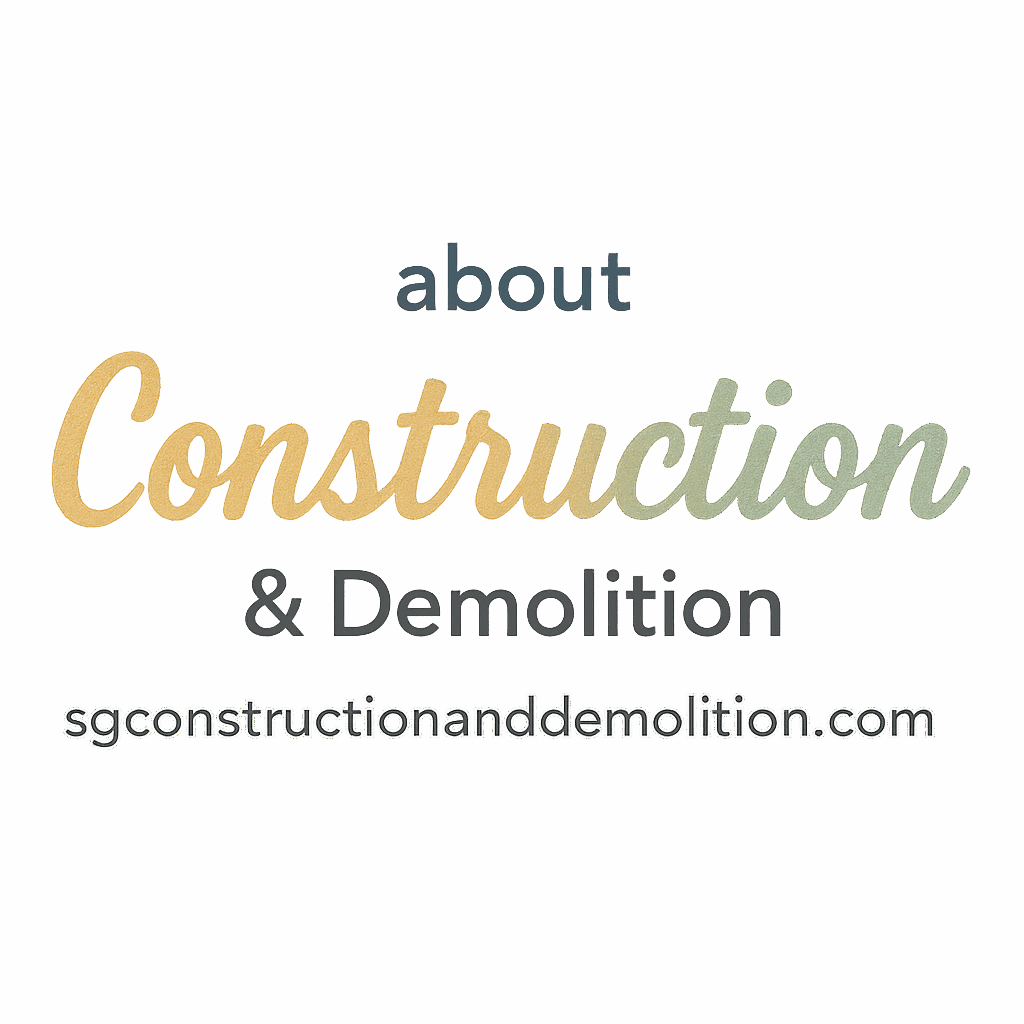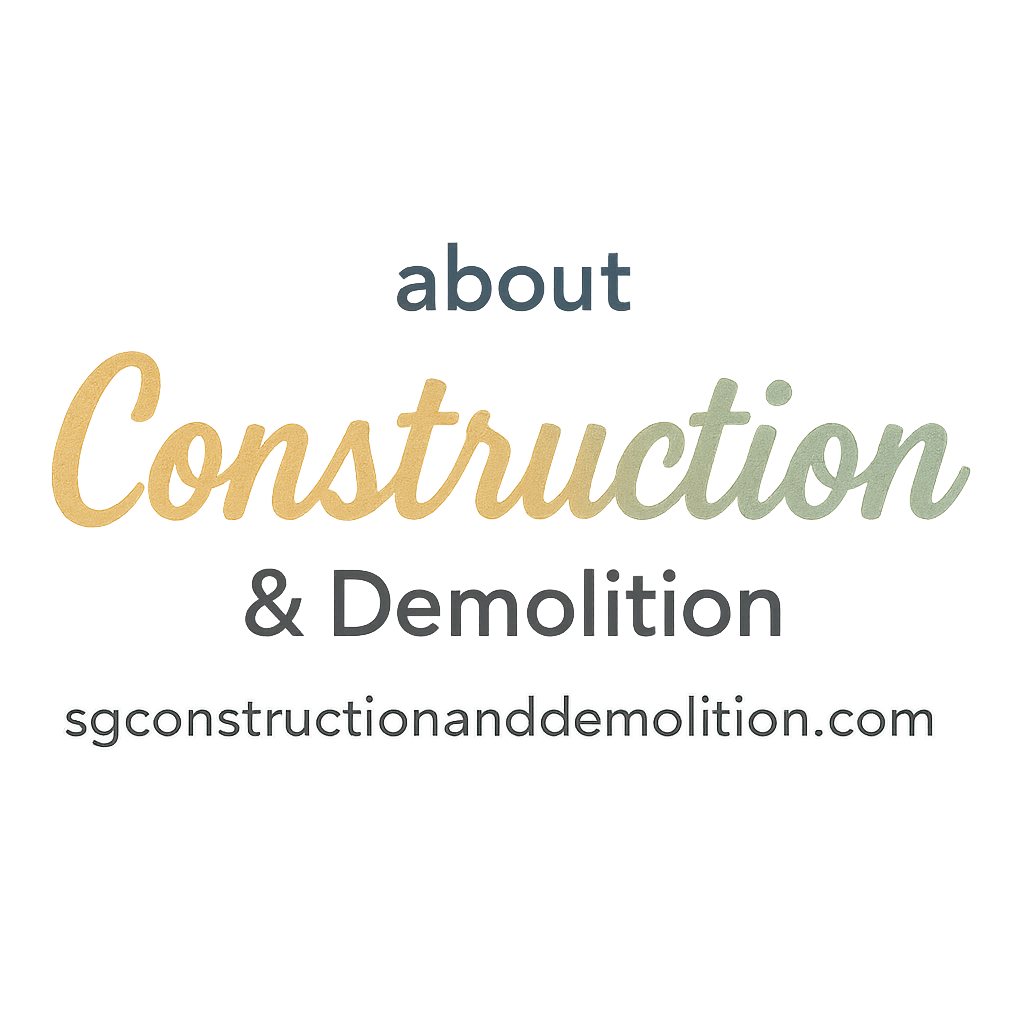Introduction
Ever watched a building crumble and wondered what kind of powerful tools made that happen? Whether you’re a seasoned builder or just starting out in construction, understanding the tools used for demolition in construction is key to getting the job done safely and effectively. Let’s break down the six most important demolition tools and how they help turn big jobs into rubble with precision and power.
If you’re a beginner looking to get familiar with demolition tools, check out SG Construction and Demolition’s Beginners Tag for helpful insights.
Why Demolition Tools Matter in Construction
Demolition is more than just smashing things—it’s a calculated, strategic process that requires the right tools for safety, speed, and efficiency.
The Role of Proper Equipment in Safety & Efficiency
You can’t bring a knife to a gunfight. Similarly, using the wrong tool in demolition can lead to accidents, wasted time, and a blown budget. Choosing the right demolition tools can mean the difference between a clean job and a chaotic disaster.
For more on safety planning, explore SG’s safety planning page.
Manual vs. Powered Demolition Tools
Some demolition work requires the brute force of manual tools, while other jobs demand machines that can tear down concrete walls in seconds. The choice depends on the size and scope of the task.
1. Sledgehammer
Overview of Sledgehammers
The classic sledgehammer is still one of the most recognizable demolition tools. It’s basically a long-handled hammer with a heavy metal head. Simple, right? But incredibly effective.
Best Use Cases
- Knocking down drywall
- Breaking up small masonry sections
- Smashing tiles and bricks
Pros and Cons
Pros:
- Low cost
- Easy to use
- No power needed
Cons:
- Labor-intensive
- Not suitable for large structures
Want more beginner-friendly techniques? Visit the Demolition Techniques Tag.
2. Jackhammer (Pneumatic Drill)
What Is a Jackhammer?
A jackhammer combines a hammer and a chisel with compressed air to deliver rapid, powerful blows. It’s the go-to for breaking up concrete and pavement.
When Should You Use One?
- Busting up concrete slabs
- Demolishing sidewalks
- Tearing apart foundation blocks
Check out the full guide on Demolition Techniques for practical how-tos.
Safety Tips for Jackhammer Use
- Wear ear protection (they’re loud)
- Use gloves to reduce vibration
- Always wear goggles for flying debris
For more on safe equipment use, visit Tools & Equipment.
3. Excavators with Hydraulic Breakers
How Excavators Help with Demolition
Excavators aren’t just for digging. With the right attachments, like hydraulic breakers, they can punch through concrete walls and structures with ease.
Attachments That Boost Performance
- Hydraulic shears – For cutting steel beams
- Grapples – For grabbing and moving debris
- Crushers – For smashing down reinforced concrete
Browse SG’s Equipment Tag to see more attachments in action.
Environmental Considerations
When using heavy machines, you also need to consider noise, dust, and energy use. Green Smart Trends provides tips for eco-conscious demolition.

4. Wrecking Balls
Are Wrecking Balls Still Relevant Today?
Once the stars of dramatic demolition scenes, wrecking balls are less common today but still used for large, open-area demolitions. They rely on simple gravity and force.
The Science Behind the Smash
A crane swings a massive steel ball into the structure. That impact shatters concrete, steel, and bricks alike.
Best Projects for Wrecking Balls
- Abandoned warehouses
- Large concrete structures
- Multi-story buildings with no nearby structures
Learn more about construction basics here.
5. Concrete Cutters and Diamond Blades
The Precision Demolition Tool
Need to surgically remove a wall section? A concrete cutter fitted with a diamond blade lets you slice cleanly through reinforced concrete.
Types of Concrete Cutters
- Walk-behind saws – Ideal for floors
- Handheld saws – Perfect for walls and tight corners
- Wire saws – Used for thick or oddly shaped concrete sections
Safety Practices and PPE
- Use respirators to avoid inhaling dust
- Ensure the blade is sharp and secure
- Keep water flowing to reduce dust and blade friction
Demolition safety starts with knowledge. Get it here: Planning Safety.
6. Bulldozers and Skid Steers
Heavy-Duty Machines for Demolition Jobs
When you need to move tons of rubble or knock down walls fast, you call in the bulldozers and skid steers. These machines bring raw force to the job site.
Comparing Bulldozers and Skid Steers
| Feature | Bulldozer | Skid Steer |
|---|---|---|
| Size | Large and powerful | Smaller, maneuverable |
| Ideal For | Large-scale demo | Indoor/small jobs |
| Attachments | Blades, rippers | Buckets, grapples |
Situations Where They Shine
- Clearing rubble quickly
- Tearing down small buildings
- Pushing materials to dump sites
Check out SG’s tag on Power Tools for more heavy machinery insights.
Choosing the Right Tool for Your Demolition Project
Every job has unique needs. Choosing the right tool isn’t just about power—it’s about precision, efficiency, and safety.
Budget, Timeline, and Scale
- Low budget & small job? Go with manual tools.
- Tight deadline? Use machines like excavators or skid steers.
- Big structure? Bring in the wrecking ball or jackhammer.
Local Regulations and Environmental Impact
Cities often have restrictions on noise levels, working hours, and emissions. If you’re aiming to demolish responsibly, visit Green Smart Trends.
For more on construction project planning, explore Project Management Tag.
Conclusion
Demolition might look like chaos, but the truth is—it’s a carefully orchestrated performance. Each tool plays a specific role, from the humble sledgehammer to the mighty wrecking ball. By understanding these 6 tools used for demolition in construction, you can tackle any teardown with confidence.
Remember, whether you’re breaking ground or tearing it up, knowing your tools is step one. So get familiar, stay safe, and demolish smart!
Want to explore more on methods and myths? Check out these tags:
Construction | Demolition | Innovation | Myths | Misconceptions
FAQs
1. What is the safest demolition tool to use for beginners?
A sledgehammer or handheld concrete cutter is usually safest for small jobs when used with proper PPE.
2. Can I rent demolition tools instead of buying them?
Yes! Many local hardware stores and equipment rental centers offer short-term rentals for tools like jackhammers or skid steers.
3. What’s the best tool for demolishing a concrete patio?
A jackhammer is ideal for patios due to its power and maneuverability.
4. Are wrecking balls still used in modern demolition?
Yes, but only in specific scenarios where space and safety regulations allow.
5. How do I know if I need a professional for demolition?
If the job involves load-bearing walls, utility lines, or large machinery, it’s safer to hire a pro.
6. What’s the difference between demolition and deconstruction?
Demolition is about tearing down, while deconstruction carefully disassembles structures to salvage materials.
7. Do I need a permit for demolition work?
In most cities—yes. Always check your local regulations before starting.


